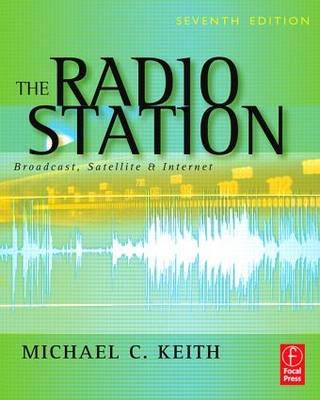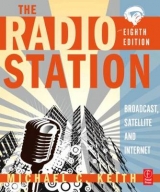
The Radio Station
Focal Press (Verlag)
978-0-240-80850-5 (ISBN)
- Titel erscheint in neuer Auflage
- Artikel merken
The bible for beginning radio professionals. A complete guide to the internal workings of radio stations and the radio industry.
Readers new to radio understand how each job is best performed, and they will know how it meshes with those of the rest of the radio station staff. For readers uncertain of career goals, this book provides a solid foundation in who does what, when, and why. The Radio Station details all departments within a radio station.
Topics explained include satellite radio, Web radio, AM stereo, cable and podcasting. Also, mergers and consolidation, future prospects, new digital technologies. This edition is loaded with new illustrations, feature boxes and quotes from industry pros.
Going strong after 20 years, The Radio Station is now in its seventh edition and long considered the standard work on this audio medium. It remains a concise and candid guide to the internal workings of radio stations and the radio industry, explaining the functions performed successfully within every well-run station.
Michael C. Keith, Ph.D., ranks among the most prolific authors on the subject of broadcast media, in particular radio. He is a member of the Communication Department at Boston College and is author of over twenty books, including Voices in the Purple Haze, Signals in the Air, Talking Radio, Radio Cultures, and Sounds in the Dark. With Robert Hilliard he has co-authored The Broadcast Century and Beyond, Waves of Rancor, Dirty Discourse, Global Broadcasting Systems, and The Hidden Screen. With Christopher Sterling he co-authored Sounds of Change: FM Broadcasting in America. In addition, he is the author of numerous journal articles and has served in a number of editorial positions. He is the past Chair of Education for the Museum of Broadcast Communications, the inaugural chair of the Broadcast Education Association's Radio Division, and a former broadcaster. He is the recipient of several honors, including the Distinguished Scholar Award given by the Broadcast Education Association in 2008, and the Stanton Fellow Award given by the International Radio Television Society. He is the author of a critically acclaimed memoir, The Next Better Place: A Father and Son on the Road (Algonquin Press), in 2003. Visit the author's website: www.michaelckeith.com.
Table of Contents:
Preface
1 STATE OF THE FIFTH ESTATE
In the Air-Everywhere
A Household Utility
A Toll on Radio
Birth of the Networks
Conflict in the Air
Radio Prospers during the Depression
Radio during World War II
Television Appears
A New Direction
Radio Rocks and Roars
FM's Ascent
AM Stereo
Noncommercial Radio
Proliferation and Frag-Out
Profits in the Air
Economics and Survival
Consolidations, Downsizings, and Clusters
Buying and Selling
DAB Revolution
Satellite and Cable Radio
Internet Radio
LPFM (Low Power FM)
PODCASTING *new
Radio and Government
Regulations
Jobs and Equality in Radio
Chapter Highlights
Suggested Further Reading
2 STATION MANAGEMENT
Nature of the Business
The Manager as Chief Collaborator
What Makes a Manager
The Manager's Duties and Responsibilities
Organizational Structure
MANAGING THE CLUSTER *new
Human Resources
Whom Managers Hire
The Manager and the Profit Motive
The Manager and the Community
The Manager and the Government
The Public File
The Manager and Unions
The Manager and Industry
Associations
Buying or Building a Radio Station
Chapter Highlights
Appendix: Code of Federal Regulations Index
Suggested Further Reading 73
3 PROGRAMMING
Program Formats
The Programmer
The Program Director's Duties and Responsibilities
PROGRAMMING SATELLITE, WEB, AND POD *new
Elements of Programming
The Program Director and the Audience
The Program Director and the Music
The Program Director and the FCC
The Program Director and Upper Management
Chapter Highlights
Appendix: A Station Owner Airchecks His Programming
Suggested Further Reading
4 SALES
Commercialization: A Retrospective
Selling Airtime
SELLING IN SATELLITE AND WEB RADIO *new
Becoming an Account Executive
The Sales Manager
Radio Sales Tools
Points of the Pitch
Levels of Sales
Spec Spots
Objectives of the Buy
Prospecting and List Building
Planning the Sales Day
Selling with and without Numbers
Advertising Agencies
Rep Companies
Co-Op Sales
Trade-Outs
Chapter Highlights
Appendix: A Station Owner Conveys His Sales Philosophy to His Manager
Suggested Further Reading
5 NEWS
News from the Start
News and Today's Radio
NEWS IN SATELLITE AND WEB OPERATIONS *new
The Newsroom
The All-News Station
The Electronic Newsroom
The News Director
What Makes a Newsperson
Preparing the News Story
Organizing the Newscast
The Wire Services
Radio Network News
Radio Sportscasts
Radio News and the FCC
News Ethics
Traffic Reports
News in Music Radio
Chapter Highlights
Suggested Further Reading
6 RESEARCH
Who Is Listening
The Ratings and Survey Services
Qualitative and Quantitative Data
In-House Research Techniques
Research Deficits
How Agencies Buy Radio
SATELLITE AND WEB RADIO AUDIENCE RESEARCH *new
Careers In Research
The Future of Research in Radio
Chapter Highlights
Suggested Further Reading
Appendix A: RAB's Radio Research Glossary
Appendix B: Arbitron's
Glossary of Terms
7 PROMOTION
Past and Purpose
PROMOTING SATELLITE AND WEB RADIO *new
Promotions Practical and Bizarre
The Promotion Director's/Manager's Job
Whom Promotion Directors Hire
Types of Promotion
Sales Promotion
Research and Planning
Budgeting Promotions
Promotions and the FCC
Broadcast Promotion and Marketing Executives
Chapter Highlights
Suggested Further Reading
8 TRAFFIC AND BILLING
The Air Supply
COMMERCIAL INVENTORY IN SATELLITE AND WEB RADIO *new
The Traffic Manager
The Traffic Manager's Credentials
Directing Traffic
Billing
The FCC and Traffic
Chapter Highlights
Suggested Further Reading
9 PRODUCTION
A Spot Retrospective
Formatted Spots
The Production Room
The Studios
MIXING IN SATELLITE AND WEB RADIO *new
Editing
Copywriting
Announcing Tips
Voice-Tracking
The Sound Library
Chapter Highlights
Suggested Further Reading
10 ENGINEERING
Pioneer Engineers
Radio Technology
AM/FM
SATELLITE AND WEB RADIO *new
Digital Audio Broadcasting (DAB)
Smart Receivers
Becoming an Engineer
The Engineer's Duties
Station Log
The Emergency Alert System (Formerly the Emergency Broadcast System)
Automation
Posting Licenses and Permits
Chapter Highlights
Appendix 10A: Federal Communications Commission Fact Sheet
Appendix 10B: SBE Application
Appendix 10C: NARTE
Application
Suggested Further Reading
11 CONSULTANTS AND SYNDICATORS
TO BE REASSESSED IN LIGHT OF CONSOLIDATION AND NEW TECHNOLOGIES
Radio Aid
Consultant Services
Consultant Qualifications
Consultants: Pros and Cons
Program Suppliers
Syndicator Services
Hardware Requirements
Syndicator Fidelity
Chapter Highlights
Appendix: Station Critique
Suggested Further Reading
Glossary
Index
| Erscheint lt. Verlag | 2.5.2007 |
|---|---|
| Verlagsort | Oxford |
| Sprache | englisch |
| Maße | 203 x 254 mm |
| Themenwelt | Kunst / Musik / Theater ► Film / TV |
| Sozialwissenschaften ► Kommunikation / Medien ► Journalistik | |
| Sozialwissenschaften ► Kommunikation / Medien ► Medienwissenschaft | |
| Technik ► Elektrotechnik / Energietechnik | |
| ISBN-10 | 0-240-80850-9 / 0240808509 |
| ISBN-13 | 978-0-240-80850-5 / 9780240808505 |
| Zustand | Neuware |
| Haben Sie eine Frage zum Produkt? |
aus dem Bereich



